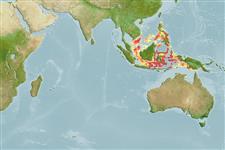>
Atheriniformes (Silversides) >
Phallostethidae (Priapiumfishes)
Etymology: Neostethus: Greek,neos = new + Greek, stetho, stethion = brest; literal = to prick a little breast (Ref. 45335).
More on author: Herre.
Environment: milieu / climate zone / depth range / distribution range
Ökologie
seewasser; süßwasser; brackwasser benthopelagisch. Tropical
Asia: Mindanao, Cuyo, Mactan, Negros Oriental and Leyte, Philippines.
Size / Gewicht / Alter
Maturity: Lm ? range ? - ? cm
Max length : 2.3 cm SL Männchen/unbestimmt; (Ref. 12768)
Occur in mangrove and nipa swamps (Ref. 280). Fertilization is internal and eggs are attached to the substrate via adhesive filaments (Ref. 43413).
Life cycle and mating behavior
Geschlechtsreife | Fortpflanzung | Ablaichen | Eier | Fecundity | Larven
Pelvic fins in males are modified to form part of a complex thoracic clasping organ (Ref. 205).
Parenti, L.R., 1989. A phylogenetic revision of the phallostethid fishes (Atherinomorpha, Phallostethidae). Proc. Calif. Acad. Sci. 46(11):243-277. (Ref. 12768)
IUCN Rote Liste Status (Ref. 130435)
Bedrohung für Menschen
Harmless
Nutzung durch Menschen
Mehr Information
Alter/GrößeWachstumLänge-GewichtLänge-LängeLängenhäufigkeitenMorphometrieMorphologieLarvenLarven Pop.Dyn.RekrutierungDichteBRUVS
ReferenzenAquakulturAquakultur ProfilZuchtlinienGenetikElectrophoresesVererbbarkeitKrankheitenVerarbeitungNutrientsMass conversion
PartnerBilderStamps, Coins Misc.LauteCiguateraGeschwindigkeitSchwimmstilKiemenoberflächeOtolithsGehirngrößeSehfähigkeit
Tools
Zusatzinformationen
Download XML
Internet Quellen
Estimates based on models
Preferred temperature (Ref.
123201): 28 - 29.1, mean 28.6 °C (based on 66 cells).
Phylogenetic diversity index (Ref.
82804): PD
50 = 0.5002 [Uniqueness, from 0.5 = low to 2.0 = high].
Bayesian length-weight: a=0.00389 (0.00180 - 0.00842), b=3.12 (2.94 - 3.30), in cm total length, based on all LWR estimates for this body shape (Ref.
93245).
Trophic level (Ref.
69278): 3.0 ±0.3 se; based on size and trophs of closest relatives
Fishing Vulnerability (Ref.
59153): Low vulnerability (10 of 100).
